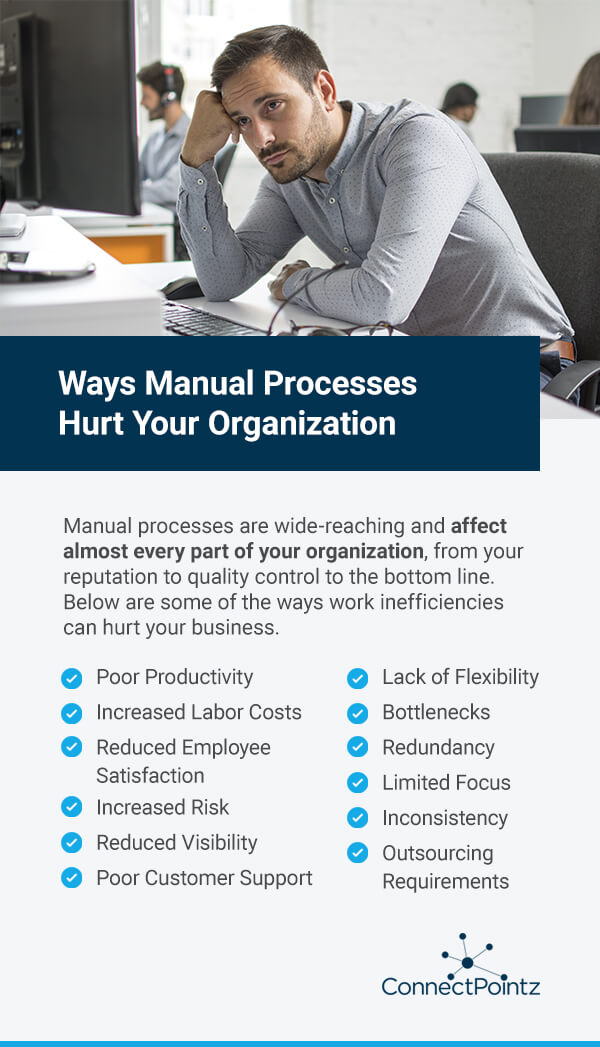
When you think of business automation, you might think of machinery. But automation encompasses a wide range of easy-to-implement digital tools and platforms that can significantly streamline and improve various business processes, particularly tedious tasks like data entry and verification. If you haven't made the move to automation, you could be hurting your company more than you realize. Manual processes have become a hindrance, putting those who use them further behind their competitors and limiting their ability to create valuable, efficient workflows.
So, what exactly is the problem with manual processes? And how do you eliminate them? Let's take a closer look at what these tasks mean for an organization and how to automate manual processes.
The Issue With Manual Processes
When we talk about manual processes, we're referring to any task carried out by a human, such as typing and sending an email or entering data. These manual tasks are essential for the ongoing success of a business, but they also introduce operational inefficiencies. Conducting these tasks takes time — time that could be better spent moving the company forward in other ways. Repetitive business processes might increase labor costs or pull resources away from more important goals.
Manual processes often involve repetitive work like copying and pasting data between multiple systems or logging in and out of those systems — brief tasks that can quickly add up to a lot of lost time. They also introduce a range of other necessary tasks, like keeping track of paperwork, requesting approvals and managing duplicate or out-of-date files.
The other problematic element of manual processes is human nature. Even the best and most focused employees make mistakes. One study found a manual transcription error rate of almost 4%. Depending on the process, you might create several opportunities for error. For example, a warehouse employee writing product quantities by hand could write the wrong number, put the right number in the wrong spot or miss a decimal point. If that data is later entered into an electronic system, it could be mistyped in the same ways.
In short, manual processes are rife with opportunities for error and inefficiency.

Ways Manual Processes Hurt Your Organization
Manual processes are wide-reaching and affect almost every part of your organization, from your reputation to quality control to the bottom line. Below are some of the ways work inefficiencies can hurt your business.
1. Poor Productivity
Copying and pasting content may not sound like it takes very long, but consider how much time is wasted when a team of employees does it 50 times per day. A few seconds for each task can add up.

Manual processes can reduce your overall productivity and make employees spend more time on basic tasks and less time bringing value to the company. They could better use that time innovating and helping you reach new heights.
2. Increased Labor Costs
All that extra time also hurts your bottom line, as you pay for the additional work. You might have skilled professionals using their time on menial processes that can simply be eliminated. You may also be paying more to fix errors that occur during manual entry. Going back and re-checking documents or re-counting a pile of products all eat into your labor budget.
Labor demands also go up with the amount of work required. The size of your staff has to scale alongside processing demands. Automation can significantly reduce labor requirements by speeding up or eliminating manual processes entirely. You can keep your team small, even in the face of changing demands.
3. Reduced Employee Satisfaction
Employees know their time is valuable. If their employer makes them use it for tedious tasks, they'll likely become frustrated. A smooth, streamlined process can create a more enjoyable workday and allow them to use their skills effectively.
In a time when employees are quick to move on to bigger and better opportunities, keeping them happy is essential to employee retention. A 2021 report tells us that six in 10 American workers changed what they value in a career or job — they want to be doing work that aligns with their values. Reducing manual efforts can usually leave time for more meaningful work.
4. Increased Risk
While humans are sometimes error-prone, computers can accomplish tasks with virtually no chance of error. If you're relying on employees to do the majority of the work, you're likely leaving the business vulnerable to mistakes. Errors can be as simple as being a number off on inventory counts or much more drastic.
No one wants inaccurate data, but it can be particularly destructive and jeopardize compliance in some industries like healthcare and financing. The increased risk of manual processes might open you up to litigation or financial penalties, along with the costs of fixing errors, such as dealing with irate customers or spending time on inventory adjustments.
Automating your processes can help mitigate risk by leaving sensitive processes in the competent hands of technology. It also helps by limiting the number of times that data needs to be handled. When systems automatically move information from one step to the next, there are fewer touchpoints or opportunities for employees to make errors.
5. Reduced Visibility
Manual processes tend to be hard to track. If you complete tasks on paper, local hard drives or other disconnected locations, the company may struggle with quality recordkeeping.
The tasks may be performed inconsistently, as every employee has their own style. One person might enter N/A if a field doesn't apply, while others might leave it blank or enter a 0. These inconsistencies can cause problems when the data is needed for other purposes such as analysis. For example, a reporting platform could interpret varying types of data in different ways, leading to flawed reports and insights.
Another side effect of poor visibility is data silos. Disconnected data often causes departments to work separately from each other without collaboration or data sharing. Data silos are a significant problem and often cause issues like repeated work and inefficient processes companywide.
Say someone from sales needs stock information to close a deal. They could wait until the next day when someone from the warehouse gets a chance to send over the information, or they could log into the system themselves and access it immediately. They can save precious time and provide a quick, responsive experience for the client.
Automation can store information in a centralized platform for simple yet secure access to companywide information, speeding up various processes and improving oversight for management.
6. Poor Customer Support
Waiting on manual processes slows down your overall response time for helping customers. Whether it's customer service, sales or something else, time-consuming tasks and decentralized data can hold you back. Customers expect snappy responses, and if you can't offer that, they just might hop over to your competitor.
Customers also expect accuracy, and if they frequently experience problems, like errors in their order or being forgotten by their sales rep, they'll have a poorer perception of the company, which could cause them to choose someone else. Keeping your processes accurate and quick can help improve customer satisfaction, allowing you to create a more enjoyable experience all around.
7. Lack of Flexibility
One of the major issues with manual processes is they aren't scalable. If you need to increase capabilities during a busy season or in response to a demand spike, you need to hire more people, train them and take care of HR requirements. It takes time and can create significant costs.
Technology, on the other hand, is easily scalable. Automation allows you to meet new demands right away without delay and, often, no extra costs. Automating manual processes can be especially useful to growing businesses or those fluctuating with the seasons.
Automation is also flexible in the sense that it allows you to adapt to operational changes, such as adding a new partner or switching your processes. Since data is standardized, it is much easier to transfer over and use in new ways.
8. Bottlenecks
Bottlenecks occur for many reasons, such as errors, inefficiency and increased demand. Manual processes are particularly susceptible to these issues and can cause a workflow to pile up in one spot, slowing down every other part of the data journey. Automation can keep bottlenecks at bay by reducing variability and seamlessly moving information along to the next step.
9. Redundancy
This is another issue related to operational inefficiency. Redundancy can occur when manual processes are repeated or duplicated. Perhaps two employees need to generate the same report and don't know someone else already did the work. Maybe they know someone else did it, but they can't find the data or don't have time to wait for the other person to send it over.
Duplicate work is simply a waste of time — if someone's already completed a task correctly, there should be no need for someone else to do it again.
Redundancy can also cause confusion. It creates multiple versions of the same information and leads employees to wonder which one is accurate and the most up-to-date. If two files cover the same data, it's easy to grab the wrong one and use inaccurate or outdated information, which affects insights and can introduce more errors that later need fixing.
10. Limited Focus

According to 41% of companies, tying up key personas with elementary data problems that prevent them from focusing on the company's digital future is the most pressing data issue. When important players in the company spend more time on repetitive, unnecessary tasks, they can't innovate or drive the business forward. Their unique skillsets don't deliver as much value as they could. Eliminating manual tasks covers the basics and gives these workers room to be creative and focus on what's important.
11. Inconsistency
Automation ensures all of your data moves through the same outline. It offers clarity and routine, making it easier for systems and people to understand the information and handle data in the same way. It also creates accountability. Lost files or paperwork will become a thing of the past, and entered data will be visible to other employees within the company.
12. Outsourcing Requirements
If you don't have enough staff to meet manual process demands, you may turn to outsourcing. While outsourcing certainly has its place, it limits the level of control you have over the process. Depending on who you outsource to, you might find more errors, inefficiency or a lack of alignment with your company's goals. Without the need for additional personnel, you can avoid outsourcing altogether and keep your work in-house, where it's easier to keep an eye on things.
The Solution: Automation
The key to eliminating manual processes lies in automation. With the right tools, you can significantly reduce or eliminate many manual processes in your organization. While you can use automation for incredibly advanced processes, you can also use it for basic, repetitive tasks. Businesses of all types can automate this low-hanging fruit, even small and medium-sized businesses (SMBs) with limited resources. Nowadays, automation tools are affordable and accessible and often require minimal IT knowledge.
With 73% of executives on the path to intelligent automation, it's clear this solution is shaping how businesses operate. It will play a major role in competitiveness and strategy for years to come.
There are a few issues that commonly appear when switching to automation, but the right solution should address them:
- Legacy systems: Older systems might not play nicely with modern platforms and tools. Automation is all about streamlining communications, so data should be able to flow freely between two systems. Your solution should integrate with whatever systems you have in place or offer application programming interfaces (APIs) that simplify integration.
- IT resources: An overworked IT team might not have the resources available to embark on a new project. Some automation solutions are easier to implement than others and can ease the process for your team.
- Flexibility: If your business processes often call for tasks that can't be automated, it can be challenging to streamline them. An automation solution may need to accommodate these exceptions and allow for a human touch while still speeding up the process.
To help you address these challenges and set yourself up for success, be sure to work with a partner who supports you every step of the way.
Eliminate Manual Processes With ConnectPointz
If your business is in retail, ConnectPointz is the go-to solution for automating manual processes. ConnectPointz helps you integrate an array of different systems, like supply chain solutions and retailer platforms that use electronic data interchange (EDI). Receive and transmit data, such as orders and invoices, securely and automatically in a centralized solution for more reliable, efficient processes. From small online retailers to large brick-and-mortar chains, ConnectPointz can help you eliminate many of the problems with manual processes.
ConnectPointz meets applicable industry standards and integrates with leading platforms for sales channels, shipping, third-party logistics, inventory, accounting and more. Whether you use Quickbooks, Shopify, Microsoft Dynamics, Amazon or something else, ConnectPointz can help with seamless built-in solutions and application programming interfaces (APIs).
ConnectPointz stands out by delivering fully customized solutions at the most affordable and predictable prices, ensuring a quick onboarding process and seamless integration with any third-party platform. Reach out to us today to learn more about ConnectPointz and see how it can automate your manual business processes to help you meet your goals.










































